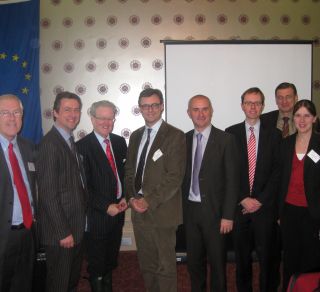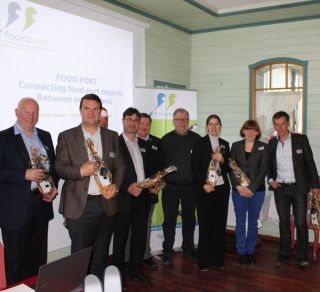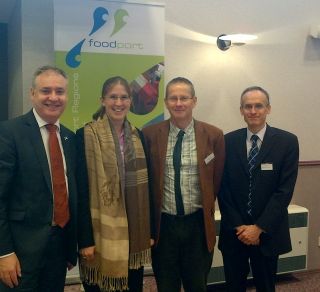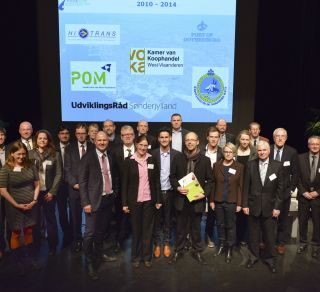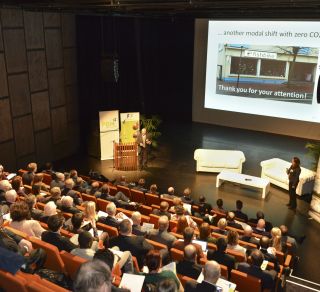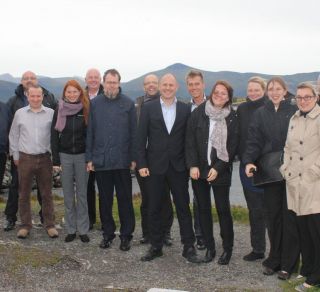 |
|

Food PortFood Port - Connecting Food Port Regions - Between and BeyondBackground and AimAim This was achieved through the optimisation and coordination of the food supply chains, delivering tangible benefits to food and logistics sectors and the companies involved (many of which were SMEs). These companies benefited from measures designed to improve efficiency, effectiveness and sustainability, leading e.g. to increased capacity, cost efficiency, a higher service level and a lower carbon footprint. Transnational cooperation across the sectors of logistics and food in the North Sea Region, would make the North Sea Region a dynamic and leading area for food distribution and processing and lead to new Value Added Logistic Activities and Value Added Services. Background As a result of early investigations, the partnership identified various inadequacies and inefficiencies in the food supply chain. For example, food distribution relied heavily on road transport, leading to congestion, poor air quality and environmental degradation. Containers delivering food to one region returned empty to their port of origin. Demands for environmentally friendly food production and distribution practices were beginning to emerge. It was anticipated that this would increase as awareness of increasing costs and damage to the environment became more apparent. The Food Port partners shared a similar motivation and interest to develop better systems of food logistics to improve the efficiency and effectiveness of the food supply chain within the North Sea Region.
Information HubWP3_1_Cor1 Rosyth Zeebrugge ferry service - strengthening an existing port-to-port service
Food Port Results Sweden RVG Nov 2013 Food Port General Brochure May 2012 Food Port General Leaflet May 2012 WP3_1_Cor1 Rosyth Zeebrugge ferry service Business Impact Study November 2011 WP3_1_Cor1 Rosyth Zeebrugge ferry service Business Impact Study Update November 2012 WP3_1_Cor1 Rosyth Zeebrugge ferry service Report Motorways of Seas Options August 2014 WP3_1_Cor2 The Findus Case - how to reduce cost and environmental impact from Swedish food export and import WP3_1_Cor3 Short Sea Shipping corridor between Mid-Norway and Bremerhaven - Feasibility Study WP3_1_Cor4 Lifting the spirit - whisky by rail WP3_1_Cor4 Lifting the spirit - whisky by rail – environmental analysis WP3_1_Cor5 Hitra Case - set up of an intermodal food corridor between Hitra and Zeebrugge WP3_1_Cor6 Scandinavia platform - set up of a food corridor between West Flanders and Västra Götaland WP3_1_Cor7 Port of Oostende -Saint Petersburg short sea service - set up of a food corridor between West Flanders and Saint Petersburg area WP3_1_Cor8 Agro Food logistics in Denmark - setting up a new Food Port corridor from Padborg to Rotterdam WP3_2_Realisation of food hubs or food distribution centres WP3_2_Fresh Cargo Hub Oostende – part 1 WP3_2_Fresh Cargo Hub Oostende – part 2 WP4_1_Fish Box Pool Project Challenges in utilising RFID in international fresh food supply chains WP4_1_Presentation ILC Technology in the Food Supply Chain WP4_2_Case Study the potential of adopting returnable transport packing systems in food transport WP4_2_Case Study Deutsche See Tests to achieve a longer shelf life of fresh fish WP5_1_Summary Scan of Regional Food Clusters WP5_1_Scan of Regional Food Clusters in the North Sea Region WP5_2_Summary Inter and Intra Regional Food Product Flows WP5_2_ Whisky Logistics Study Spirits of the Highlands WP5_2_Identification and analysis of food flows in Västra Götaland WP5_3_Food Logistic Cluster Management WP5_3_The Food Port Transnational Action Plan WP5_4_Sustainable Food Logistic Scenarios WP5_4_Article Sustainable Logistic Scenarios in the NSR Region WP5_4_Cost and time models for road haulage and intermodal transport using Short Sea Shipping in the North Sea Region WP5_4_LCA of food transports and tomato production. A comparison of different food transport scenarios, including production of tomatoes There are no related videos
|
